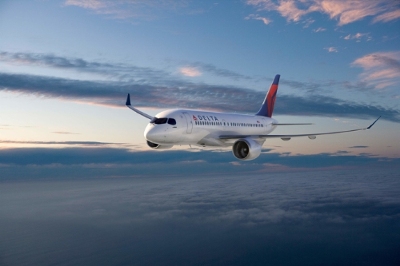
News Release Issued: Apr 28, 2016 (6:00am EDT)
Order for 75 CS100 small narrowbody aircraft balances improved customer experience, operating economics with efficient capital deployment
ATLANTA, April 28, 2016 /PRNewswire/ — Delta Air Lines (NYSE: DAL) will continue its narrowbody fleet renewal with the state-of-the-art Bombardier C Series, providing for added network flexibility with more fuel-efficient mainline aircraft.
Delta Orders State-of-the-Art, Fuel-Efficient Bombardier C Series
As the U.S. launch customer, Delta’s firm order for 75 CS100s allows the company to cost-effectively reshape and upgauge its narrowbody fleet, providing an improved customer experience and better cost efficiency while maintaining a focus on prudent capital deployment.
“As we reshape our fleet for the future, the innovative onboard experience of the C Series is a perfect complement for the top-notch service provided every day by Delta people,” said Ed Bastian, Delta’s incoming chief executive. “These new aircraft are a solid investment, allowing us to take advantage of superior operating economics, network flexibility and best-in-class fuel performance.”
This transaction is part of Delta’s domestic strategy to upgauge the fleet, allowing the company to achieve its long-term financial targets, including 15 percent EPS growth and generation of $4-5 billion in free cash flow annually, while replacing less efficient domestic aircraft. With the order of the C Series, Delta will no longer induct the E190 into its fleet as planned.
Powered by Pratt & Whitney’s latest geared turbofan PW1500G engine, the CS100 takes advantage of advanced technology and composite materials designed to deliver an expected 20 percent improvement in fuel efficiency over similar sized aircraft when it enters service with Delta in spring 2018. The reduced noise and emissions of the C Series aligns with Delta’s broader goal to reduce the airline’s environmental footprint.
“We are very proud to welcome Delta as a C Series customer and to expand our partnership with such a prestigious airline,” said Alain Bellemare, President and Chief Executive Officer, Bombardier Inc. “Given Delta’s position as one of the world’s largest and most respected airlines, this deal is a strong endorsement of the C Series as the best performing aircraft in the 100-150 passenger class. The addition of Delta to our marquee C Series customer list gives us tremendous momentum as we approach entry-into-service this summer.”
The CS100 features a state-of-the-art interior with the largest windows in the single-aisle market, full-spectrum ambient lighting, seatback in-flight entertainment, in-flight Wi-Fi, high-capacity overhead bins and among the widest seats of any narrowbody aircraft in a customer-preferred two-by-three Main Cabin and Delta Comfort+ configuration, as well as a two-by-two First Class layout.
Bombardier’s all-new, lightweight mainline aircraft will be deployed on short- to medium-haul routes throughout the airline’s network. As part of this transaction, Delta has options for 50 additional C Series aircraft and certain delivery flexibility rights including the ability to substitute the larger CS300 aircraft. The order means Delta will fly customers on more Bombardier aircraft than any other carrier.
Delta has been replacing inefficient, older technology airplanes generating substantial cost improvement and increased customer satisfaction. Since 2009, Delta has retired 280 50-seat regional jets and more than 130 older, narrowbody aircraft, while refreshing its fleet with over 300 aircraft.
Delta is phasing out some of the airline’s less fuel-efficient planes. Fuel use per passenger mile has been reduced by 8 percent since 2008. The C Series transaction, combined with orders for other narrow and widebody aircraft will reduce the carbon footprint of the fleet and supports Delta’s financial and environmental strategy to consume less fuel.
Forward Looking Statements
Statements in this press release that are not historical facts, including statements regarding our estimates, expectations, beliefs, intentions, projections or strategies for the future, may be “forward-looking statements” as defined in the Private Securities Litigation Reform Act of 1995. All forward-looking statements involve a number of risks and uncertainties that could cause actual results to differ materially from the estimates, expectations, beliefs, intentions, projections and strategies reflected in or suggested by the forward-looking statements. These risks and uncertainties include, but are not limited to, the cost of aircraft fuel; the impact of rebalancing our hedge portfolio, recording mark-to-market adjustments or posting collateral in connection with our fuel hedge contracts; the availability of aircraft fuel; the effects of terrorist attacks or geopolitical conflict; the possible effects of accidents involving our aircraft; the restrictions that financial covenants in our financing agreements will have on our financial and business operations; labor issues; interruptions or disruptions in service at one of our hub or gateway airports; disruptions or security breaches of our information technology infrastructure; our dependence on technology in our operations; the effects of weather, natural disasters and seasonality on our business; the effects of an extended disruption in services provided by third party regional carriers; failure or inability of insurance to cover a significant liability at Monroe’s Trainer refinery; the impact of environmental regulation on the Trainer refinery, including costs related to renewable fuel standard regulations; our ability to retain management and key employees; competitive conditions in the airline industry; the effects of extensive government regulation on our business; the sensitivity of the airline industry to prolonged periods of stagnant or weak economic conditions; and the effects of the rapid spread of contagious illnesses.
Additional information concerning risks and uncertainties that could cause differences between actual results and forward-looking statements is contained in our Securities and Exchange Commission filings, including our Annual Report on Form 10-K for the fiscal year ended Dec. 31, 2015. Caution should be taken not to place undue reliance on our forward-looking statements, which represent our views only as of April 28, 2016, and which we have no current intention to update.
Delta Air Lines and the Delta Connection carriers offer service to nearly 370 destinations on six continents. For more information visit news.delta.com.
SOURCE Delta Air Lines
For further information: Delta Corporate Communications, 404-715-2554
Commentaires